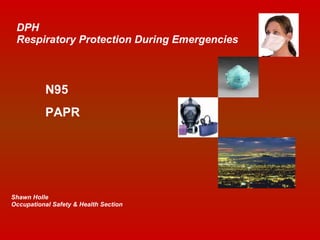Rpp Training
- 1. DPH Respiratory Protection During Emergencies Shawn Holle Occupational Safety & Health Section N95 PAPR
- 2. What is a Respirator? Protects Against Multiple Airborne Contaminants
- 3. Respirators vs. Surgical Masks Surgical Masks Protect By Keeping It IN Respirators Protect By Keeping it OUT
- 4. Why Respiratory Protection? Isolation Unit Workers Exposed to Airborne Transmissible Diseases (ATDs) Emergency Planning & Preparedness DPH Wants to Be Prepared in Any Contingency Respiratory Protection Included in Long Range Planning
- 5. Cal-OSHA Requirements: Title 8, 5144 Written Respiratory Protection Program Medical Evaluation Proper Use Procedures Recurrent Fit Testing & Training Inspection & Maintenance Procedures Program Evaluation
- 6. Written Respiratory Protection Program Defines Responsibilities Provides Information on Respirator Selection Provides Information on Program Implementaton & Maintenance
- 7. Roles & Responsibilities Administration Implement Program OSH Section Review Questionnaires Provide Annual & in Time Fit Testing Provide Annual & in Time Training
- 8. Roles & Responsibilities Employees Attend Medical Evaluations, Training, & Fit Testing No Facial Hair Inform Supervisor: Unable to Wear Respirator Does Not Fit Malfunctions
- 9. Medical Evaluations Required Questionnaire Reviewed by HCP Further Medical Examination at SFGH OHS Clinic Employee May Use Personal Physician Confidential Medical Results Employer Is Told if Employee Can Wear a Respirator
- 10. Potential Exposures Airborne Transmissible Diseases TB Pandemic Flu Outbreak Avian Flu SARS Smallpox
- 11. DPH Selected Respirators N 95 Facepiece Filtering Respirators High Efficiency Particulate Air (HEPA) Powered Air Purifying Respirators (PAPRs)
- 12. N95 Facepiece Filtering Respirator Recommended by CDC for Use Against ATDs User Draws Air Through the Facepiece 95% of Particles Blocked .80 Cents Each
- 13. N95 Limitations They Leak Risk Reduced But Not Eliminated Facial Hair Compromises Seal Don’t Work O2 Deficient Atmospheres Breathing Resistance Increases Over Time
- 14. PAPRs Battery Motor Sucks Air Through Filters 99.97% of Particles Blocked Pushes Fresh Air Into the Headpiece $800 Each For Complete Ensemble
- 15. PAPR Limitations Can’t Be Used in O2 Deficient Atmospheres 8 - 10 Hour Battery Life Noisy Expensive
- 16. Improper Fit, Usage or Maintenance Can Compromise Respirator Protection Right Tool the Right Way
- 17. Respirator Training Required Emergency Workers Retrained As Needed Isolation Unit Workers Annually Trained
- 18. Fit Testing Required Quantitative: Compares Outside Particles to Inside Particles Qualitative: Fit Determined Subjectively Fit Testing Will Be Conducted at Multiple DPH Sites As Needed (Just In Time Fit Testing)
- 19. N95 Usage Inspections Visual Inspection Before & After Use Check Strap Integrity Check for Facepiece Tears or Cuts Check For Deformities
- 20. N95 Usage Putting on the Respirator Cup Respirator in Hand With Straps Hanging Place Respirator Onto Face (Chin First) Pull Top Strap Over & Position At Back of Head Pull Bottom Strap Over on Neck Below Ears Use Fingertips to Shape Nose Clip
- 21. How Long Can I Wear an N95? 8 to 12 Hours if Kept Clean Not Damaged Permitted by Infection Control Practices Discard Respirator Immediately If Damaged Wet Increased Breathing Resistance
- 22. Removing N95 Place Gloved Hand Over Front of Facepiece Pull Straps Over Head Remove Respirator From Face Discard In Glove
- 23. Respirator Storage Routine Use Respirators Located On Site Emergency Use Respirators Cached Throughout DPH System
- 24. Summary Use Respirator As Trained Facial Hair Decreases Protection Inform Supervisor of Any Respirator Problems























